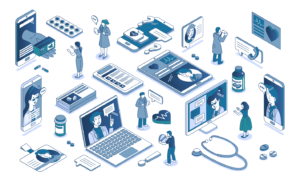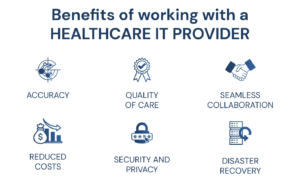Importance of Information Technology Services in Healthcare
In the current era of technology, healthcare services have a great implementation of emerging technologies. By the virtue of these technologies, the global quality of patient care is improving each day. Information technology services in the healthcare department are serving extraordinary benefits to improve the overall quality of health.
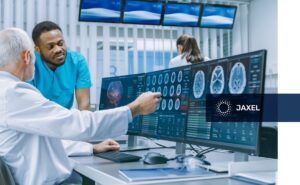
The support of technology in healthcare is there for many years. The Healthcare sector is an important department that has taken a lot of benefits due to the adoption of technology. It helps health professionals to diagnose and treat diseases in a much better way. Correspondingly, it enhanced the overall quality of life in the long run and it has rescued countless lives.
At the same time, health information technology (HIT) is applying to health and health care. It ensures the sharing of health information among consumers, providers, payers, and quality monitors by the use of a computerized system. Additionally, electronic health record (EHR) is another technology tool to manage the records of patients. In general, it has improved the quality of life by boosting the safety and efficacy of the health delivery system. According to a 2006 report by the Agency for Healthcare Research and Quality, rational adoption of HIT would:
- Improve health care quality
- Increase health care productivity
- Prevent medical errors
- Increase health care accuracy
- Reduce health care costs
- Increase administrative efficiencies
- Decrease paperwork
- Expand access to affordable care
What is Health Information Technologies?
Health information technology refers to various technologies that range from simple charting to advanced integration with medical technology. Since health professionals are adopting health information technologies at an accelerated rate to improve patients’ safety and health. Here is a summary of some currently available technologies which have a significant impact to improve patient safety:
Electronic Physician’s Orders and E-Prescribing
Computerized physician order entry systems primarily designed to enhance the safety of medication prescriptions. At the present time, modern systems assign electronic ordering of tests, various procedures, and physician consultations as well. Computerized physician order entry systems are integrated with a clinical decision support system (CDS) in most cases. Moreover, it plays a critical role to prevent errors by guiding the health professionals on the standard drug doses, route, and frequency of administration.
Clinical Decision Support
Clinical decision support (CDS) hands over the patient-specific information to the health care professional. This information plans to empower the decision of the healthcare provider. It is processed and presented to the healthcare provider at required times. Clinical decision support (CDS) refers to a range of tools to improve decision-making and the clinical work system. These tools encompass notifications, alerts, and reminders to health care providers and patients. Additionally, these tools include clinical guidelines, condition-specific order sets, patient-specific clinical summaries, documentation templates, investigation, and diagnostic support. CDS systems enhance the quality of care and patient compliance but the consequences may fluctuate with various system designs and implementation methods.
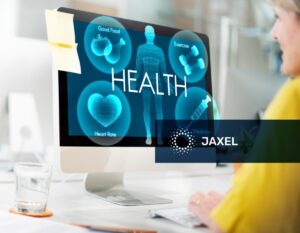
Electronic Sign-Out and Hand-Off Tools
Particularly, sign-out or “hand-over” communication is a continuous process of delivering information from health professionals to patients. Patient-specific information passes from one caregiver to another or from one team of caregivers to the next. Ultimately the information conveys to the patient and family to ensure patient care continuity and safety. Electronic sign-out applications are tools integrated with the electronic medical record to assure an organized transfer of patient information in the course of healthcare provider handoffs.
Bar Code Medication Administration
Bar code medication administration systems make use of bar code technology. It is a medication administration record system integrated with bar code technology. It helps the health professionals for satisfactory administration of medicines. Moreover, it assures that the right medication is administered to the right patient at right time. Some software gives sound alerts to remind them time and dose of medicine administration, while others arrange clinical advisories for certain medications on scanning. Identically, bar code medication administration system is playing a significant role in reducing medication administration-related errors.
Smart Pumps
Smart pumps are intravenous infusion pumps that are assembled with medication error-prevention software. This software provides alerts to the operator if the setting of infusion is set outside of pre-configured safety limits. Thus, smart pumps help to reduce medication errors and improve patient safety.
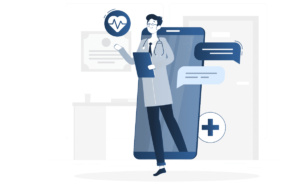
Automated Medication Dispensing Technology
Automated dispensing cabinets (ADC) are electronic drug cabinets for storage of medication. It helps to manage the medication inventory at hospitals via automatic medication dispensing. This tool helps to reduce the workload on the central pharmacy. Moreover, it maintains the track of medication dispensing and patient billing. Likewise, it plays a vital role in reducing medication errors in intensive care units (ICU) at hospitals.
Patient Electronic Portals
A patient portal is an online application that hands over patients access to their personal health information. It provides two-way electronic coordination with their health care provider using a computer or a mobile device. The patient portals improve aftereffects of preventive care and disease awareness. However, they have little impact to improve patient safety outcomes.
Telemedicine
Telemedicine refers to the use of telecommunication technologies to promote communication between patients and health care providers. Additionally, telemedicine may present health information that is gathered remotely from medical devices or personal mobile devices. This information may be used for monitoring patients, tracking, or changing their behavior.

Synchronous Telemedicine
Synchronous telehealth occurs in live, real-time settings where the health care provider communicates with patients via phone or video conference. As a matter of fact, there is direct communication between patient and health care provider to diagnose a disease, select a suitable treatment plan, or prescribe suitable medicines. Of course, synchronous communication impacts patient health positively in critical care, psychiatric care, and chronic disease care. Furthermore, this technology opens doors of guidance from the specialist concerning the management of the patient beyond referring the patient. Thus, e-consults may trim patient wait intervals for specialist appointments and consultations to diagnose a situation.
Remote Patient Monitoring
Remote patient monitoring is a technology to monitor the patients outside the conventional clinical environment using digital systems to record the medical data from patients. Then, the collected data assessed by health care professionals for further recommendations and instructions. It reforms patient outcomes for some chronic conditions like; heart failure, stroke, COPD, asthma, and hypertension. Additionally, it plays a considerable role to reduce medication errors.
Electronic Incident Reporting
Electronic incident reporting systems are web-based systems that support healthcare providers to reduce incidents. Moreover, these systems exhibit the following advantages:
- Standardize reporting structure
- Rapid identification of serious incidents
- Standardize incident action workflow
- Automatic data entry and analysis
Benefits of Information Technology in Healthcare
Information Technology Services is serving healthcare in plenty of ways. Here is the list of some of the benefits of information technology:
- Information technology facilitates health professionals to save and retrieve data narrating a patient’s health records.
- It improved the coordination of patient info via an easy and coherent format that anyone can use.
- Information technology plays a vital role to reduce the occurrence of medication errors.
- It makes it accessible to retrieve patient info via a database beyond extra health checks.
- The medical technology tools virtually ensure patient safety.
- There are specific alert flags and reminders on medication, a physician consultation, and diagnosis reports. Particularly, these alerts help patients adhere to specific treatments and schedules of taking medicines.
- Database backups ensure data security and maintain the privacy of patients.
- Electronic recording of data has led to storing data safely and facilitates the health practitioners a lot. Moreover, the use of electronic health records (HER) has improved the care provided to the patients.
Correspondingly, all the above Information Technology Services in healthcare have improved health and patient safety. They also help the health professional to complete their tasks successfully. However, there is a need to innovate new things in the medical sector with advancements in technology tools.
all quality of health.








